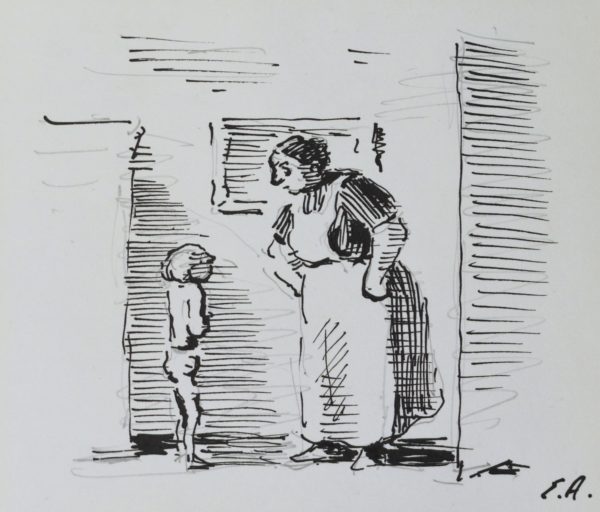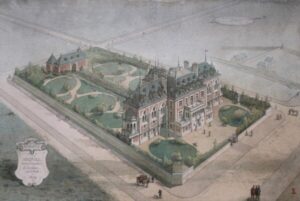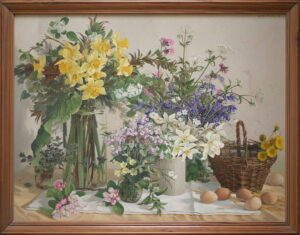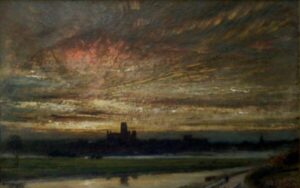Ardizzone, Edward (1900-1979)
Edward Jeffrey Irving Ardizzone, CBE RA (16 October 1900 – 8 November 1979) was an English painter, print-maker and war artist, and the author and illustrator of books, many of them for children. For Tim All Alone (Oxford, 1956), which he wrote and illustrated, Ardizzone won the inaugural Kate Greenaway Medal from the Library Association for the year's best children's book illustration by a British subject. For the 50th anniversary of the Medal in 2005, the book was named one of the top ten winning titles, selected by a panel to compose the ballot for public election of an all-time favourite. Ardizzone's father, Auguste Ardizzone, was a naturalized Frenchman of Italian descent, who was born in Algeria, then a colony of France, and worked on overseas government service elsewhere in the French colonial empire. Ardizzone's mother, Margaret, was English. Her father, Edward Alexander Irving was the assistant colonial secretary of Singapore. Edward Ardizzone was born in the port city of Haiphong, in what is now Vietnam, but was then known as Tonkin, in the north of French Indo-China, whilst his father was working for the Eastern Extension Telegraph Company. In 1905, Margaret Ardizzone returned to England with her three eldest children. They were brought up in Suffolk, largely by their maternal grandmother, whilst Margaret returned to join her husband in the Far East. The Ardizzone family lived in Ipswich at Corder Road between 1905 and 1910, and in Gainsborough Road from 1911 to 1912. Ardizzone was educated first at Ipswich School and then at Clayesmore School, a boarding school in Wokingham from 1912. At Claysmore his interest in art was encouraged by an art teacher. Ardizzone left school in 1918 and twice tried to enlist in the British Army but was refused. After spending six months at a commerce college in Bath, Ardizzone spent several years working as an office clerk in both Warminster and London, where he began taking evening classes at the Westminster School of Art, which were taught by Bernard Meninsky. In 1922 Ardizzone became a naturalized British citizen. While working as an office clerk, Ardizzone had spent his weekends and free time painting and in 1926, with financial support from his father, gave up his office job to concentrate on establishing himself as a professional, freelance artist. Ardizzone's first major commission was to illustrate an edition of In a Glass Darkly by Sheridan Le Fanu in 1929. He also produced advertising material for Johnnie Walker whisky and illustrations for both Punch and The Radio Times. The first book by Ardizzone listed by the US Library of Congress is The Mediterranean: An anthology (London: Cassell, 1935, OCLC 2891569), compiled by Paul Bloomfield, "decorated by Edward Ardizzone" with "each chapter preceded by illustrated half-title". In 1936 he inaugurated his best-known work, the Tim series of books, featuring the maritime adventures of its eponymous young hero, which he both wrote and illustrated. Little Tim and the Brave Sea Captain was published by Oxford University Press in both London and New York that year. In 1939, he illustrated the first of a series of four Mimff children's books by H.J.Kaesar. By 1939, Ardizzone was holding one-man exhibitions on a regular basis, with shows at the Bloomsbury Gallery and later the Leger Gallery. At this time the major theme of his paintings were scenes of life in London, with affectionate illustrations of the pubs and parks near his home in the Maida Vale area of the city. His style was naturalistic but subdued, featuring gentle lines and delicate watercolours, but with great attention to particular details. In World War II, after a short spell in an anti-aircraft unit, Ardizzone worked as a full-time, official war artist assigned to the War Office by the War Artists' Advisory Committee. He first served with the British Expeditionary Force and depicted their retreat through France and Belgium before being evacuated back to Britain from Boulogne in May 1940. In Britain he recorded troops at their training camps and spent nights sketching in the London Underground, where tube tunnels were being used as air-raid shelters during the Blitz. Ardizzone spent the early part of 1941 travelling around Scotland. In January 1942 he recorded the arrival of American troops in Northern Ireland. In March of that year he went to Cairo and joined the British First Army on its march to Tunisia, and then joined the Eighth Army. By July 1943 Ardizzone was in Sicily, where he witnessed combat at close quarters, and unusually for him, painted the aftermath of the fighting. He travelled on through Italy with the Eighth Army until April 1944, when he flew to Algiers, from where he sailed back to Britain. In June 1944 he went to France during the Allied invasion, but by September 1944 was back in Italy. He again travelled widely there and witnessed the fall of Reggio Calabria and Naples. He spent the winter of 1944 in Italy before travelling to Germany for the final months of the War. By the time Ardizzone returned to England in May 1945 he had completed almost 400 sketches and watercolours of the War, most of which, along with his wartime diaries, are held at the Imperial War Museum. His early experiences between Arras and Boulogne are illustrated and described in his book Baggage to the Enemy (London 1941), while Diary of a War Artist, published in 1974, described his later experiences during the conflict. After the War, Ardizzone resumed his freelance career and received commissions from The Strand Magazine for cover artwork, from the Ealing film studios for promotional material and from the Guinness company for adverts. Ardizzone was commissioned to produce a watercolour portrait of Winston Churchill and continued to write and illustrate books. The most famous Tim book is the inaugural Greenaway Medal-winner, Tim All Alone (Oxford, 1956). The series continued until 1972 with Tim's Last Voyage which was followed in 1977 by Ship's Cook Ginger. Beside writing and illustrating his own books, Ardizzone also illustrated books written by others, including some editions of Anthony Trollope novels. His 1939 characterisation of H. E. Bates's My Uncle Silas is inimitable. He illustrated the C. Day Lewis children's novel, The Otterbury Incident (1948). One of his happiest collaborations was that with Eleanor Farjeon, especially on The Little Bookroom (Oxford, 1955 collection). Ardizzone illustrated some novels by the American author Eleanor Estes, including Pinky Pye, The Witch Family, The Alley, Miranda the Great, and The Tunnel of Hugsy Goode (1958 to 1972). In 1962 he illustrated an edition of J. M. Barrie's Peter Pan, retold by Eleanor Graham, and A Ring of Bells (1962), John Betjeman's abridged version for children of his autobiographical poem Summoned by Bells (1960). For illustrating Titus in Trouble, written by James Reeves, Ardizzone was a commended runner-up for the 1959 Greenaway Medal. Ardizzone is particularly noted for having not just illustrated the covers and contents of books, but inked in the title text and author's name in his own hand, giving the books a distinctive look on shelves. An example is Clive King's Stig of the Dump from 1963. The Nurse Matilda series of children's books (1964–74) was written by his cousin Christianna Brand, who was seven years younger. Their shared grandmother had told the stories to both cousins and she had learned them from her father. Early in the 1970s, Ardizzone illustrated a new edition of the 20-year-old Little books by Graham Greene: The Little Train, The Little Fire Engine, The Little Horse Bus, and The Little Steamroller. He also illustrated a re-telling of the Don Quixote story for children by James Reeves and his illustrations for the The Land of Green Ginger by Noel Langley are regarded as classics in their own right. His 1970 autobiography, The Young Ardizzone - an autobiographical fragment, was illustrated with his own drawings. Ardizzone also illustrated several telegrams for the Post Office in the 1950s and 1960s, many of which are considered collectors' items. He also held a number of teaching posts, working part-time as an instructor in graphic design at Camberwell School of Art and as a visiting tutor at the Royal College of Art. In 1960 he retired from his teaching posts and began spending more time at Rodmersham Green in Kent before moving there permanently in 1972. In 1929, Ardizzone had married Catherine Josephine Berkley (1904-1992) and the couple had two sons and a daughter. Ardizzone died of a heart attack in 1979 at his home in Rodmersham Green. After Catherine's death in 1992, the British government accepted 64 of Ardizzone's sketchbooks in lieu of inheritance tax and these are now held by the Ashmolean Museum in Oxford. The British Library published an illustrated bibliography of his works in 2003. A blue plaque unveiled in 2007 commemorates Ardizzone's home at 130 Elgin Avenue in Maida Vale.



